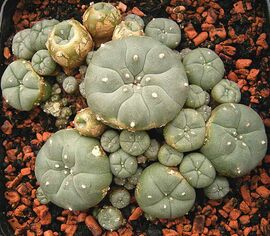Lophophora williamsii: Difference between revisions
>Blackhole Added a reputable external resource on Peyote from The Third Wave |
>Unity patrol-reverting |
||
| Line 15: | Line 15: | ||
*[https://en.wikipedia.org/wiki/Peyote Peyote (Wikipedia)] | *[https://en.wikipedia.org/wiki/Peyote Peyote (Wikipedia)] | ||
*[https://erowid.org/plants/peyote/peyote.shtml Peyote (Erowid)] | *[https://erowid.org/plants/peyote/peyote.shtml Peyote (Erowid)] | ||
*[https://erowid.org/experiences/subs/exp_Peyote.shtml Peyote experiences (Erowid)] | *[https://erowid.org/experiences/subs/exp_Peyote.shtml Peyote experiences (Erowid)] | ||
Revision as of 15:48, 7 September 2017
Please avoid harvesting peyote in its natural habitat. Peyote populations are rapidly declining in nature due to over-harvesting by non-indigenous peoples. As a result, it is currently a threatened species.[1][2] Those who wish to consume peyote are encouraged to grow their own or use alternative mescaline-containing cactus species such as San Pedro or Peruvian Torch. |
| Lophophora williamsii | |
|---|---|
 Peyote in a pot. |
|
| Taxonomical nomenclature | |
| Kingdom | Plantae |
| Unranked | Angiosperms |
| Unranked | Eudicots |
| Unranked | Core eudicots |
| Order | Caryophyllales |
| Family | Cactaceae |
| Genus | Lophophora |
| Species | L. williamsii |
| Common nomenclature | |
| Common names | Peyote, Peyotel (in Latin America) |
| Constituents | |
| Active constituents | Mescaline, Pellotine, Hordenine, etc. |
Lophophora williamsii, also known as peyote or peyotel, is a slow growing spineless cactus with psychoactive alkaloids like mescaline and pellotine.[3] Native North Americans are likely to have used peyote, often for spiritual purposes, for at least 5,500 years.[4]
Distribution and habitat
Etymology
The word peyote is the Spanish form of the ancient Nahuatlan word peyotl. Some etymologist suggested that this word is derived from the aztec word "pepeyoni" (means to excite) or "pepeyon" (to activate).[5] de Molina claimed that it is derived from the Nahuatlan word "peyutl" which means "silk cocoon or caterpillar's cocoon".[6]
Alkaloids in different Lophophora species
According to the study by Dr. Štarha,[7] all varieties of peyote contain approximately 0.7 mg of mescaline per gram of living plant. Both Lophophora diffusa and Lophophora fricii are found to be low in mescaline and high in pellotine.
| Alkaloid (mg/gram of alive plant) | L. williamsii | L. jourdaniana | L. diffusa | L. fricii | L. koehresii |
|---|---|---|---|---|---|
| Tyramine | 0.5 - 1 | 0.6 | 0.1 | 0.1 | 0.1 |
| Hordenine | 5 - 8 | 2 - 9 | 0.5 | 0.4 | 0.4 |
| Mescaline | 15 - 30 | 31 | 1.2 | 1.1 | 1.3 |
| Pellotine | 14 - 17 | 17.8 | 86.2 | 65.2 | 88.4 |
| Anhalonidine | 14 | 20.1 | 3.8 | 25.9 | 3.5 |
Study by Dr. Štarha in the Grym, Rudolf (1997) book.[8]
External links
References
- ↑ Martin Terry (Sul Rose State Univ., A. (19 November 2009). "IUCN Red List of Threatened Species: Lophophora williamsii". IUCN Red List of Threatened Species.
- ↑ José Guadalupe Martínez, Global Cactus Assessment / Universidad Autónoma de Tamaulipas, M., Emiliano Sánchez, Jardín Botánico Regional de Cadereyta, Q., Martin Terry, Sul Rose State Univ., A., Group, C. G.-H., IUCN S. C. & S. P. S. (18 November 2009). "IUCN Red List of Threatened Species: Lophophora diffusa". IUCN Red List of Threatened Species.
- ↑ http://www.ncbi.nlm.nih.gov/pubmed/5065448
- ↑ El-Seedi HR, De Smet PA, Beck O, Possnert G, Bruhn JG (October 2005). "Prehistoric peyote use: alkaloid analysis and radiocarbon dating of archaeological specimens of Lophophora from Texas". J Ethnopharmacol.
- ↑ PEYOTE (LOPHOPHORA WILLIAMSII) AND PLANTS CONFUSED WITH IT by Richard Evans , Harvard University (November 19, 1937) | http://www.jstor.org/stable/41762659
- ↑ Peyote: The Divine Cactus By Edward F. Anderson, Page 160
- ↑ Grym, Rudolf (1997). Rod/Die Gattung Lophophora. Bratislava: Vydavateľstvo Roman Staník. ISBN 80-900933-9-6. (The book features an appendix on Lophophora chemistry by Dr Roman Štarha.)
- ↑ Grym, R. (1997). Rod Lophophora: = Die Gattung Lophophora. Stanik [u.a.] ISBN 9788090093393.